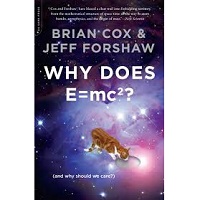Why Does E=MC2 and Why Should We Care by Brian Cox EPUB & PDF – eBook Details Online
- Status: Available for Free Download
- Authors: Brian Cox and Jeff Forshaw
- Publish Date: July 14, 2009
- Language: English
- Genre: Relativity, Sciences, Physics
- Format: PDF / EPUB
- Size: 2 MB
- Pages: 264
- Price: Free
- ISBN: 0306817588
Space and Time
What do the words “space” and “time” mean to you? Perhaps you picture space as the blackness
between the stars as you turn your gaze toward the sky on a cold winter’s night. Or maybe you see
the void between earth and moon sailed by spacecraft clad in golden foil, bedecked with the stars
and stripes, piloted into magnificent desolation by shaven-headed explorers with names like Buzz.
Time may be the tick of your watch or the reddening of the leaves as the earth’s yearly circuit of the
sun tilts northern latitudes toward shade for the 5 billionth time. We all have an intuitive feel for
space and time; they are part of the fabric of our existence. We move through space on the surface
of our blue world as time ticks by.
During the late years of the nineteenth century, a series of scientific breakthroughs in apparently
unrelated fields began to force physicists to reexamine these simple and intuitive pictures of space
and time. By the early years of the twentieth century, Albert Einstein’s colleague and tutor Hermann
Minkowski was moved to write his now-famous obituary for the ancient arena within which planets
orbit and great journeys are made:
“From henceforth, space by itself, and time by itself, have
vanished into the merest shadows and only a kind of blend of the two exists in its own right.”
What could Minkowski have meant by a blend of space and time? To understand this almost
mystical-sounding statement is to understand Einstein’s special theory of relativity—the theory that
introduced the world to that most famous of all equations, E = mc2
, and placed forever center-stage
in our understanding of the fabric of the universe the quantity with the symbol c, the speed of light.
Einstein’s special theory of relativity is at its heart a description of space and time. Central to the
theory is the notion of a special speed, a speed beyond which nothing in the universe, no matter how
powerful, can accelerate. This speed is the speed of light; 299,792,458 meters per second in the
vacuum of empty space.
Traveling at this speed, a flash of light beamed out from Earth takes eight
minutes to pass by the sun, 100,000 years to cross our own Milky Way galaxy, and over 2 million
years to reach our nearest galactic neighbor, Andromeda. Tonight, the largest telescopes on Earth
will gaze outward into the blackness of space and capture ancient light from distant, long-dead suns
at the edge of the observable universe.
This light began its journey over 10 billion years ago, several
billion years before the earth was formed from a collapsing cloud of interstellar dust. The speed of
light is fast, but nowhere near infinitely so. When faced with the great distances between the stars
and galaxies, light speed can be frustratingly slow; slow enough that we can accelerate very small
objects to within a fraction of a percent of the speed of light with machines like the 27-kilometer
Large Hadron Collider at the European Center for Particle Physics (CERN) in Geneva, Switzerland.
For More Read Download This Book
EPUB



